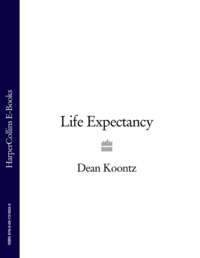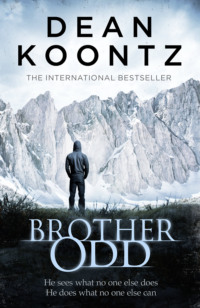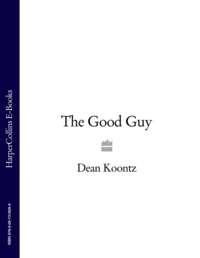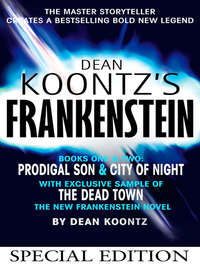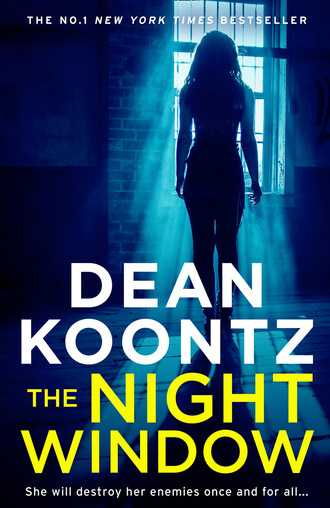
Полная версия
The Night Window
When she opened the door at the main entrance, she saw another man standing by her metallic-gray Ford Explorer Sport in the public parking lot, talking on his phone. Tall, lean, dressed all in black, he was too distant for her to see his face. But on this mild sunny day, his knee-length raincoat might have been worn to conceal a sawed-off shotgun or maybe a Taser XREP 12-gauge that could deliver an electronic projectile and a disabling shock from a distance of a hundred feet. He looked as real as death and yet phantasmal, like an assassin who had slipped through a rent in the cosmic fabric between this world and another, on some mystical mission.
The Explorer, a stolen vehicle, had been scrubbed of its former identity in Mexico, given a purpose-built 700-horsepower 502 Chevy engine, and purchased from a reliable black-market dealer in Nogales, Arizona, who didn’t keep records. There seemed to be no way it could have been tied to her.
Instead of stepping outside, she closed the door and turned to her right and made her way through the shelves of books. The aisles weren’t a maze to her, because she had scouted the place when she arrived, before settling at the computer.
An EXIT sign marked a door to a back hallway that was fragrant with fresh-brewed coffee. Offices. Storerooms. An open refreshments niche with a refrigerator. A short hall intersected the longer one, and at the end, another door opened out to a small staff-parking area with an alleyway beyond.
Three cars and a Chevy Tahoe had occupied this back lot when she’d checked it earlier.
Now, in addition to those vehicles, a white Cadillac Escalade stood in the fifth of seven spaces, to the west of the library’s rear door. The woman in the driver’s seat of the Caddy had the same caramel complexion and black hair as the man at the computer. She had a phone to her ear and was speaking to someone, which didn’t prove complicity in a plot, though her eyes fixed on Jane like a shooter’s eyes on a target.
In any crisis situation, the most important thing to do was get off the X, move, because if you weren’t moving away from the threat, someone with bad intentions was for damn sure moving closer to you.
Avoiding the Escalade, Jane went east. Along the north side of the alley, shadows of two-, three-, and four-story buildings painted a pattern like castle crenellations on the pavement, and she stayed in that shade for what little cover it provided, moving quickly past Dumpsters standing sentinel. To the south, past the library, there was a park, and beyond the park a kindergarten with a fenced playground.
She was opposite the park, where phoenix palms rustled in a light breeze and swayed their shadows on the grass, when the tall man in the raincoat appeared as if conjured, coming toward her, not running, in no hurry, as though it was ordained that she was his to take at will.
The structures to her left housed businesses, the names of which were emblazoned on the back doors: a gift shop, a restaurant, a stationery store, another restaurant. The buildings in that block shared walls, so there were no service passages between enterprises.
When a sedan pulled into the east end of the alley and angled to a stop, serving as a barricade, Jane didn’t bother to look behind herself, because she had no doubt the Escalade had likewise blocked the west end of the alleyway.
As she hurried along, she tried doors, and the third one—CLASSIC PORTRAIT PHOTOGRAPHY—wasn’t locked. She went inside, where a series of small windows near the ceiling admitted enough light to reveal a combination receiving area and storage room.
The shelves were empty. When she turned to the alley door to engage the deadbolt, the lock was broken.
She’d been skillfully herded to this place. The previous tenant had moved out. She had walked into a trap.
3
The formal dining room, which seats twenty, isn’t intimate enough for the conversation that Wainwright Hollister intends to have with Thomas Buckle. They are served in the breakfast room, which is separated from the immense kitchen by a butler’s pantry.
A large Francis Bacon painting of smudges, whorls, and jagged lines is the only painting in the twenty-foot-square chamber, a work of alarming dislocations that hangs opposite the ordered vista of nature—groves of evergreens and undulant meadows—visible beyond the floor-to-ceiling windows.
They sit at the stainless-steel and cast-glass table. Buckle faces the windows, so the immense and lonely nature of the ranch will be impressed upon him by the time he learns that he is to be hunted to the death in that cold vastness. Hollister faces the young director and the painting behind him, for the art of Francis Bacon reflects his view of human society as chaotic, confirms his belief in the need to impose order by brute power and extreme violence.
The chef, Andre, is busy in the kitchen. Lovely Mai-Mai serves them, beginning with an icy glass of pinot grigio and small plates of Andre’s Parmesan crisps. She wears a verbena fragrance as subtle as the mere memory of a scent.
Tom Buckle is clearly charmed by the girl’s beauty and grace. However, the almost comic awkwardness with which he tries to engage her in conversation as she performs her duties has less to do with sexual attraction than with the fact that he is out of his element, the son of a tailor and a seamstress, abashed by the splendor of the wealth all around him and uncertain how to behave with the staff of such a great house. He chats up Mai-Mai as if she were a waitress in a restaurant.
Because she’s well trained, the very ideal of a servant, Mai-Mai is polite but not familiar, at all times smiling but properly distant.
When the two men are alone, Hollister raises his glass in a toast. “To a great adventure together.”
He is amused to see that Buckle rises an inch or two off his chair, intending to get up and lean across the table in order to clink glasses with his host. But at once the director realizes that the width of the table will make this maneuver awkward, that he should take his cue from Hollister and remain seated. He pretends to have been merely adjusting his position in the chair as he says, “To a great adventure.”
After they taste the superb wine, Wainwright Hollister says, “I am prepared to invest six hundred million in a slate of films, but not in a partnership with a traditional studio, where I’m certain the bookkeeping would leave me with a return far under one percent or no return at all.” He is lying, but his singular smile could sell ice to Eskimos or apostasy to the pope.
Although Buckle surely knows that he’s in the presence of a man who thinks big and is worth twenty billion dollars, he is all but struck speechless by the figure his lunch companion has mentioned. “Well … that is … you could … a very valuable catalog of films could be created for that much money.”
Hollister nods agreement. “Exactly—if we avoid the outrageous budgets of the mindless special-effects extravaganzas that Hollywood churns out these days. What I have in mind, Tom, are exciting and intense and meaningful films of the kind you make, with budgets between twenty and sixty million per picture. Timeless stories that will speak to people as powerfully fifty years from now as they will on their initial release.”
Hollister raises his glass again in an unexpressed endorsement of his initial toast. Buckle takes the cue, raising his glass as well and then drinking with his host, a vision of cinematic glory shining in his eyes.
Leaning forward in his chair, with a genial warmth that he is able to summon as easily as a man with chronic bronchitis can cough up phlegm, Hollister says, “May I tell you a story, Tom, one that I think will make a wonderful motion picture?”
“Of course. Yes. I’d love to hear it.”
“Now, if you find it clichéd or jejune, you must be honest with me. Honesty between partners is essential.”
The word partners visibly heartens Buckle. “I couldn’t agree more, Wayne. But I want to hear it out to the end before I comment. I’ve got to understand the roundness of the concept.”
“Of course you know who Jane Hawk is.”
“Everyone knows who she is—top of the news for weeks.”
“Indicted for espionage, treason, murder,” Hollister recaps.
Buckle nods. “They now say she even murdered her husband, the hero Marine, that he didn’t commit suicide.”
Leaning forward a little more, cocking his head, Hollister speaks in a stage whisper. “What if it’s all lies?”
Buckle looks perplexed. “How can it all be lies? I mean—”
Holding up one hand to stop the young man, Hollister says, “Wait for the roundness of the concept.”
He leans back in his chair, pausing to enjoy one of the Parmesan crisps.
Buckle tries one as well. “These are delicious. I’ve never had anything quite like them. Perfect with this wine.”
“Andre, my chef,” Hollister says, “is an adjusted person. He is obsessed with food. He lives only to cook.”
If the term adjusted person strikes Thomas Buckle as odd, he gives no indication of puzzlement.
After a sip of wine, Hollister continues. “According to friends of hers, Jane became obsessed with proving her husband, Nick, didn’t commit suicide, that he was murdered, and when she took a leave of absence from the FBI, she devoted herself to investigating Nick’s death. On the other hand, authorities and media say she was merely putting up a good front to divert suspicion from her role in his death. We’re told she drugged him and got him into the bathtub and slit his throat, cutting his carotid artery with his Marine Ka-Bar knife in such a way that it looked to the coroner as if he’d taken his own life. But what if that’s all a lie?”
Buckle is intrigued. “What if is the essence of storytelling. So what if?”
Hollister continues with relish. “Jane told friends that in her research she found a fifteen-percent increase in suicides during the past few years, that all of it involved well-liked, stable people successful in their professions, happy in their relationships, none with a history of depression, people like her husband.”
“A few nights ago,” Tom Buckle says, “on that TV show Sunday Magazine, they did an hour about Hawk. They included experts who said the rate of suicide isn’t constant. It goes up, goes down. And all this about happy people killing themselves isn’t the case.”
“Remember my what-if, Tom. What if it’s all a lie, and some in the media are part of it? What if Jane Hawk is on to something, and they need to demonize her with false charges, silence her?”
“You see this as a conspiracy story.”
“Exactly.”
“Well, then, it sure would be a conspiracy of unprecedented proportions.”
“Unprecedented,” Hollister agrees. “Heroic. Involving thousands of powerful people in government and the private sector. Let’s say these conspirators called themselves … Techno Arcadians.”
“Arcadia. From ancient Greece. A place of peace, innocence, prosperity. Essentially Utopia.”
Hollister beams and claps his hands twice. “You are just the young man to understand my story.”
“But why ‘techno’?”
“Do you know what nanotechnology is, Tom?”
“Very tiny machines made up of a handful of atoms, or maybe molecules. They say it’s the future, with unlimited medical and industrial applications.”
“You are so cutting-edge,” Hollister declares and pushes a call button on the table leg. “When I saw your films, I said, ‘This is a guy on the cutting edge.’ I’m delighted to see I was right.”
In answer to the silent summons, Mai-Mai returns to freshen their wine and remove the empty plates that held the Parmesan crisps.
Thomas Buckle smiles at her and thanks her, but he seems to have intuited that the proper behavior in these circumstances is to treat her with reserve, not as if she were working at Olive Garden.
The entertainment business hasn’t coarsened him yet, for though Mai-Mai fascinates and attracts him, he watches her not with evident lust, but with an almost adolescent wistfulness and yearning.
When the two men are alone once more, Hollister says, “Let’s suppose these conspirators, these Techno Arcadians, have developed a nanomachine brain implant, a control mechanism, that makes complete puppets of the people in whom it’s installed. And the puppets don’t know what’s been done to them, don’t know they’re now … property.”
The director blinks, blinks, and a certain quiet excitement comes over him that has nothing to do with six hundred million dollars, that arises from his passion for filmmaking.
“So … central to the story would be the issue of free will. A conspiracy intent on subjugating all humanity, the death of freedom, a sort of technologically imposed slavery.”
Hollister grins like an amateur author thrilled that a real writer found merit in his scenario. “You like it so far?”
“I damn well do. I like it more by the minute. Even though Jane Hawk inspired the idea, we can’t say this is her story, so we’d have to change the character to maybe a CIA agent or something, make her a little older. Maybe it’s even a male lead. But one thing … why would anyone submit to having such a brain implant surgically installed?”
Leaning forward again, punctuating his revelation with a wink, Hollister speaks in a stage whisper. “No surgery required. You drug them or otherwise overpower them when they’re alone, and the implant is administered by injection.”
4
Jane Hawk hurried out of the storage room. Milky daylight spilled through a large sales area and curdled to gray in a hallway. Two doors stood open on each side of the hall, a shadowy bath and dark empty offices.
At the front of the store, two frosted-glass show windows each bore the words CLASSIC PORTRAIT PHOTOGRAPHY painted in script, reversed from Jane’s perspective. Between the windows stood a door with a frosted inlay, and as she approached it, a man shape loomed beyond like a stalker emerging out of fog in a disturbing dream.
He must be one of them. She’d have to take him down to get to the street and away, but even if he was a mortal threat, she could not risk resorting to gunfire when there were sure to be pedestrians on the sidewalk.
The tall man in the raincoat might already be entering the back of the place from the alleyway.
Jane’s attention swung toward an interior door to her right, four panels of solid wood, no glass. If it was only a closet, she was cornered.
Instead, beyond lay stairs ascending into gloom. In nearly blinding darkness, she used the handrail to guard against a fall until she arrived at a landing. Another flight led up to a second landing where pale light issued from an open door.
Perhaps the photographer who had once run a business out of the ground floor had lived above his studio.
Considering that the people closing in on her seemed to have herded her into this building, one of them might be waiting in the second-floor apartment.
Her heart labored but didn’t race, for she was in the grip of dread rather than full-blown fright. If these were Arcadians—and who else could they be?—they were not going to kill her here. They were going to corner her, Taser her, chloroform her, and convey her to a secure facility where she could scream herself hoarse without being heard by anyone sympathetic to her plight.
Ultimately they were going to inject her with the neural lace that would web her brain and enslave her. Then they would drain from her the names of everyone who had been of assistance to her in this crusade and would insist upon knowing the whereabouts of her five-year-old son, Travis. When she was their obedient puppet, they would eventually instruct her to kill herself.
But not just herself. She knew these elitist creeps. She knew the icy coldness of their minds, the blackness of their hearts, the pure contempt with which they viewed those who did not share their misanthropic view of humanity and did not endorse their narcissism. They would relish cruel vengeance for the trouble she had caused them, for their comrades who had tried to murder her and had been killed instead. They would instruct her to torture her own child and slaughter him; only when he was brutally ravaged and dead would they tell her to kill herself. In the thrall of the nanoweb, with its filaments wound through her brain, she would be unable to resist even the most horrific of their commands.
Compared to injection, a quick death would be a mercy.
She put her tote beside the open door. Drew the Heckler & Koch Compact .45 from the rig under her sport coat. She hated clearing doorways in such situations, but there was no time to hesitate.
Pistol in a two-hand grip, leading with head and gun, low and fast, she crossed the threshold, stepped to the right, back against the wall, eyes on the Heckler’s front sight as she swept the room left to right.
Three windows facing the street. No blinds or drapes. Morning light slanting in under scalloped fabric awnings. No furniture. No carpeting on the hardwood floor. Nothing moved except a few dust balls stirred by the slight draft she’d made on entering.
An archway connected this room to others toward the back of the building, where darkness reigned, and there was a door on the right, ajar.
She held her breath and heard only silence. Both training and intuition argued that if someone was in the apartment with her, he would have made a move by now.
The silence was broken when a sound rose from below, perhaps someone ascending the stairs.
She returned to the apartment entrance to retrieve her tote. Among other things, it contained $90,000, all of which—and more—she had taken from the stashes of wealthy Arcadians who had tried and failed to kill her. She couldn’t afford to lose it; she was fighting a quiet war, but a war nonetheless, and wars cost money.
The building was old, and the stairs creaked under the weight of whoever was climbing them.
She closed the door. The deadbolt was intact. She engaged it.
5
Mai-Mai serves a small chopped salad sprinkled with pine nuts and crumbles of feta cheese.
Tom Buckle smiles and thanks her and watches her lithe form as she exits through the butler’s pantry.
When the girl is gone, Wainwright Hollister says, “I need to explain how an injectable brain implant might be feasible, Tom. I don’t want you to think of this as a science-fiction movie. It’s a thoroughly contemporary thriller.”
“I know a little about nanotech, Wayne, just enough to accept the premise.”
“Good. Very good. Now suppose hundreds of thousands of these microscopic constructs can be suspended in ampules of fluid and stored at temperatures between—oh, let’s say—thirty-six and fifty degrees, where they remain in stasis. When injected, the warmth of the blood gradually activates them. They’re brain-tropic. The veins conduct them to the heart, then the carotid and vertebral arteries bring them to the brain. Do you know what the blood-brain barrier is, Tom?”
Buckle evidently finds the salad highly agreeable and pauses to swallow a mouthful before saying, “I’ve heard of it, but I’m no whiz when it comes to medical matters.”
“Nor do you need to be. You’re an artist and a damn fine one. Ideas and emotions are the stuff of your work. So … the blood-brain barrier is a complex biological mechanism that allows vital substances in the blood to penetrate the walls of the brain’s numerous capillaries while keeping out harmful substances such as certain drugs. Let’s imagine these amazingly tiny nanoconstructs have been designed to pass through the blood-brain barrier, after which they assemble into a control mechanism in the brain.”
“Could they really self-assemble? I mean … many, many thousands of them?”
“An excellent question, Tom. We wouldn’t have a viable story if I didn’t have an answer!” Hollister pauses to enjoy his salad.
“It’s snowing.” Thomas Buckle points to the windows behind his host.
Hollister turns in his chair to watch the first snowflakes, the size of quarters and half dollars, spiraling out of the low clouds like some jackpot disgorged by a celestial slot machine.
Refocusing his attention on his guest, he says, “The forecast is for twelve inches. Temperature will drop to the low twenties by nightfall. No wind yet, but it’s coming. Winter lingers on these plains. Have you experienced a storm in territory such as this?”
“I’m a California boy. My experience of snow is entirely from TV and movies.”
Hollister nods. “If a man were on the run from a killer on a night like the one coming, his least concern might be his would-be assassin. The weather itself could be the deadlier foe.” Before Buckle might wonder at this odd statement, his host favors him with a beguiling smile. “I’ve got a story in mind for just such a movie. But before I bore you with a second scenario, let’s see if I can make my nano tale convincing to the end. You asked how these tiny constructs could be made to self-assemble in the brain. Have you heard the term ‘Brownian movement’?”
6
Jane was at the moment safe behind the locked door of the second-floor apartment, although not safe for long.
This was a two-story building, and like all the buildings on this block—whether two, three, or four stories—it had a flat roof with a low parapet. There would be an exit to the roof somewhere in these rooms, probably by way of a metal spiral staircase tucked into a service closet.
But she didn’t want to go up and out that way. If she got to the roof through a trapdoor or through a stairhead shed, she might discover that they had anticipated her and had stationed one of their own up there to greet her. Then she would have nowhere to go.
Even if no sonofabitch with an XREP Taser waited above, Jane didn’t fancy a wild flight across rooftops as in a James Bond flick. Although the buildings varied in height, they were contiguous, and she was likely to find service ladders bolted to walls to allow roof-maintenance men easy passage from one elevation to another. However, she’d already counted five agents in this operation, so there might be more. And if they had mounted a force of that size, they might also have a drone at their service.
She’d previously survived an encounter with two weaponized drones in a San Diego park, something similar to a DJI Inspire 1 Pro with a three-axis gimbaled camera. An eight- or ten-pound drone couldn’t be fitted with even a miniature belt feed loaded with .22-caliber rounds, because the recoil would destabilize the craft. But those in San Diego featured a low-recoil compressed-air weapon that fired needle-like quarrels perhaps containing a tranquilizer.
The people now closing in on her would not risk using such a drone on a busy suburban street in a commercial district, but they might keep one hovering above the roofs where, if she appeared, she could be at once dropped unconscious without much chance that anyone at street level would see the assault.
The prospect of a machine assailant gave her a deeper chill than did a thug with a Taser XREP 12-gauge, not necessarily for good reason, but because it seemed to herald a new world in which those people not enslaved by nanoweb neural lace would be policed and punished by robots incapable of empathy or mercy.
She went to the front windows of the apartment living room, which faced onto the street and offered her the best—the only—chance of escaping capture.
7
Sitting with his back to the windows, Hollister is so attuned to the moment, so looking forward to Tom Buckle’s sudden realization of his dire situation, so enthusiastic about the pending hunt, his senses so heightened that he can almost feel the huge snowflakes spiraling through the windless day behind his back, can almost hear those delicate wheels of crystal lace turning as they descend, can almost smell the blood that will form patterns in brilliant contrast across a canvas of snow.




